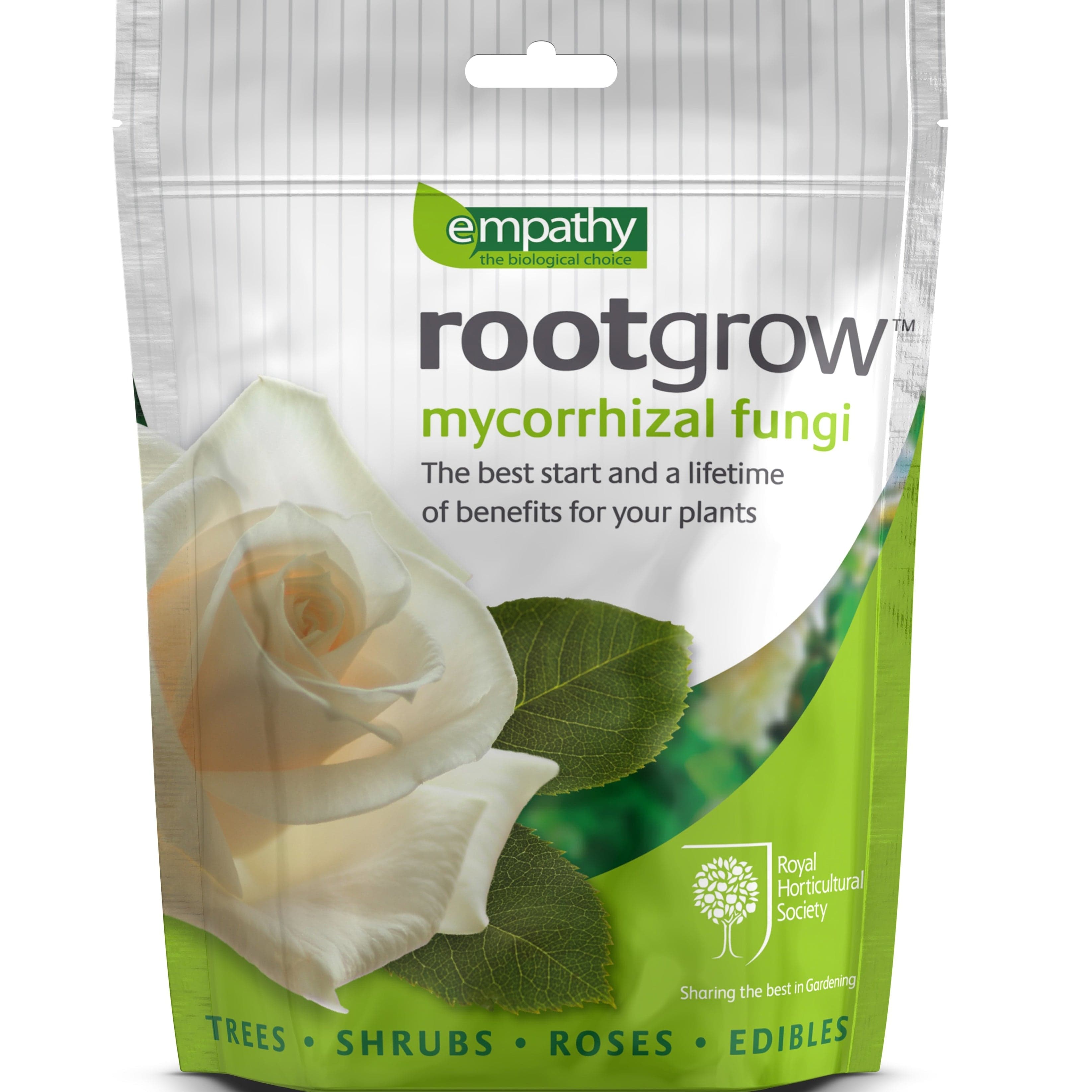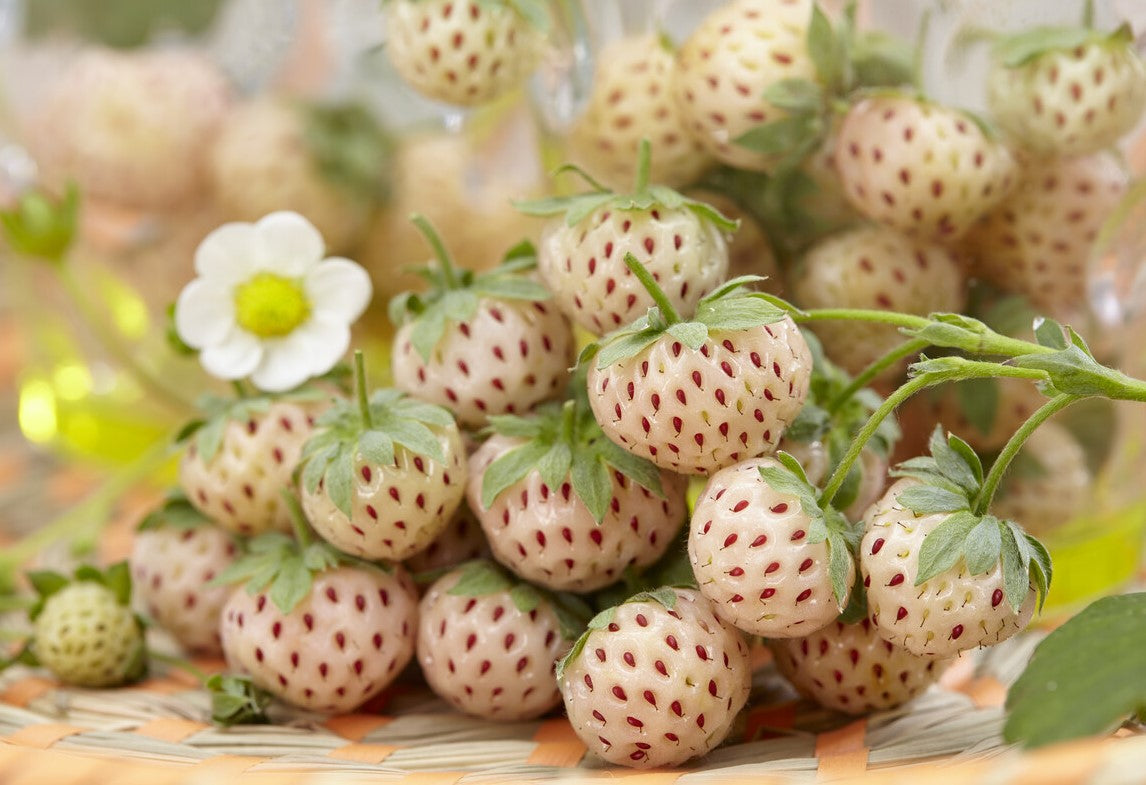How to Grow Strawberries in the UK

They’re everyone’s favourite summer fruit by a mile and they’re not even hard to grow, so swerve the plastic punnets, get stuck in and get your own strawberry supply direct from the garden (or the balcony, or the windowsill). Our growers have all the tips and tricks you need to get the best bowl of strawberries and cream ever - including which kinds to grow, how to keep pests away and how to get them cropping in time for Wimbledon…
Jump to:
- Are strawberries easy to grow?
- Best varieties
- Are strawberries perennial?
- How to grow from seed
- How to grow from runners and plants
- Planting strawberries
- Growing in pots
- Growing in a greenhouse
- Plant care
- Harvesting and storing
- Problem solving
- Multiplying strawberry plants
Are strawberries easy to grow?
They’re one of the easiest fruits you can grow, so strawberries are an ideal first crop for beginners or to grow with children. Strawberry plants will happily do their own thing, fruiting and reproducing themselves for years without any human intervention, but they’re also one of those crops where a small amount of extra work will yield a big difference in results! If you’re really serious about your strawbs, read on and find out how to get the most from your plants.
The best strawberries to grow
Summer fruiting strawberries
These are by far the most common type of strawberry - you could be forgiven for thinking they were the only kind. Most people grow these as the UK’s conditions are well suited to their growing period and they produce the biggest fruits. Top tip: summer fruiting is a bit of a misnomer as some fruit earlier or later, right up until autumn. If you get three different varieties - one early, one mid and one late cropping - you could get strawberries from June to at least September. Growing some in a greenhouse will extend the harvest even further!
Everbearing strawberries
AKA perpetual strawberries, these varieties are harder to come by and produce fruit in smaller quantities over a longer period, from early June until the first frosts of autumn. The fruits are smaller (but no less tasty) and they don’t tend to produce runners as frequently, which could be a good or a bad thing, depending on your view.
Wild strawberries
Wild, woodland or alpine strawberries - whatever you call them, they taste incredible. Sweeter and more fragrant than the larger version, they’re most often red but you can sometimes find white or yellow varieties. The plants can be grown from seed (see below) and produce small crops, usually without runners.
White strawberries
Not all strawberries are red - have you seen the pineberry? It’s like a strawberry in reverse, with white flesh and red seeds. Not only that, but the flavour has a hint of pineapple. It’s worth growing a white fleshed variety not just for the unique taste and visual appeal, but because birds will leave them alone, thinking they’re not ripe.
Are strawberries perennial?
Strawberry plants are perennials, so they come back every year and usually produce fruit reliably for around five years. They do tend to slow down after two or three years, at which point you may want to replace them if you’re short on space. This can help to reduce the build up of diseases in the soil if that’s been a problem for you.
How to grow strawberries from seed
The only strawberries that are usually grown from seed are alpine strawberries and occasionally everbearing varieties - summer fruiting types are always grown from runners or plants.
Bear in mind that it can take around six weeks for strawberry seeds to germinate, so you should start them off indoors in spring about eight weeks before the last frost is predicted in your area, or in autumn for overwintering. Sow your seeds thinly on the top of a tray of compost and cover with another thin layer. They’ll need a temperature between 18-21°C to germinate, so it’s best to keep them in a warm, sheltered place, using a heated propagator or seedling heat mat. Once they’re large enough to handle, you can pot on your seedlings into individual pots, then plant them outdoors after the last frost.
Growing strawberries from runners or plants
All three kinds of strawberries can be grown from runners, plugs, potted plants or bare roots. You can buy these in spring or repot the runners from your own plants.
Strawberry runners
These are available as bare root in autumn or in spring, when they’ll look like little clumps of roots with a few leaves.
Potted strawberries
If you buy potted strawberry plants, make sure you wait until after the last frost in your area to plant them outside. If there’s a few weeks to go before that date, you can pot them on into larger pots and keep them indoors until it’s warm enough outside.
Plug plants
Plug plants are seedlings or young plants which are available in several different sizes and will need to be grown on before they go into their final position. When you get these, remove them from their packaging straight away, plant each one in its own pot of compost and grow it in a warm, sunny spot until it’s big enough to plant out.
Bare root strawberries
This is usually the best value way of buying strawberry plants, but you’ll have to plan ahead as they’re only available from November to March, when the plants are dormant. Bare root plants are sent to you without a pot or compost and should be planted out as soon as you get them - any day when the ground isn’t frozen or waterlogged is fine. If the roots are dry, you’ll need to soak them in water for an hour or two before planting.

Planting strawberries
When to plant
Plant potted strawberry plants or runners in March or April, or bare roots from November to March.
Where to plant
The best position for your strawberry bed or pots is a warm, sheltered spot where your plants will get a full six to eight hours of sunlight every day throughout the growing season. They’ll also need a well drained soil with plenty of nutrients, so if you’re planting in the ground, it’s a good idea to mix in some well rotted manure or compost.
How to plant strawberries
To plant strawberry runners or plants, dig a hole big enough for the roots and place your plant in the centre, spreading the roots out so they fill the hole. Fill in with compost or soil, making sure the crown of the plant (the centre) is resting just above the surface. If the foliage is under the soil it will rot; if it’s too high above it the plant will dry out, so it’s worth taking your time and getting it just right. If you’re planting more than one, leave 30-45cm space between each plant, and 75-100cm between rows, then water your plants well. It’s also a good idea to put a layer of straw mulch around your strawberries at this point, or use strawberry collars, to keep the fruit off the ground and prevent mould.
How long do strawberries take to grow?
Strawberry plants will fruit in around twelve weeks, so if you plant them in April, you should be able to harvest them in June or July. If you go for bare root plants, these are planted between November and March and will also fruit in June. Growing from seeds requires a bit more patience, as they need anywhere up to six weeks to germinate and twelve weeks plus to grow to maturity after that, so you’re probably looking at the following year before they fruit.
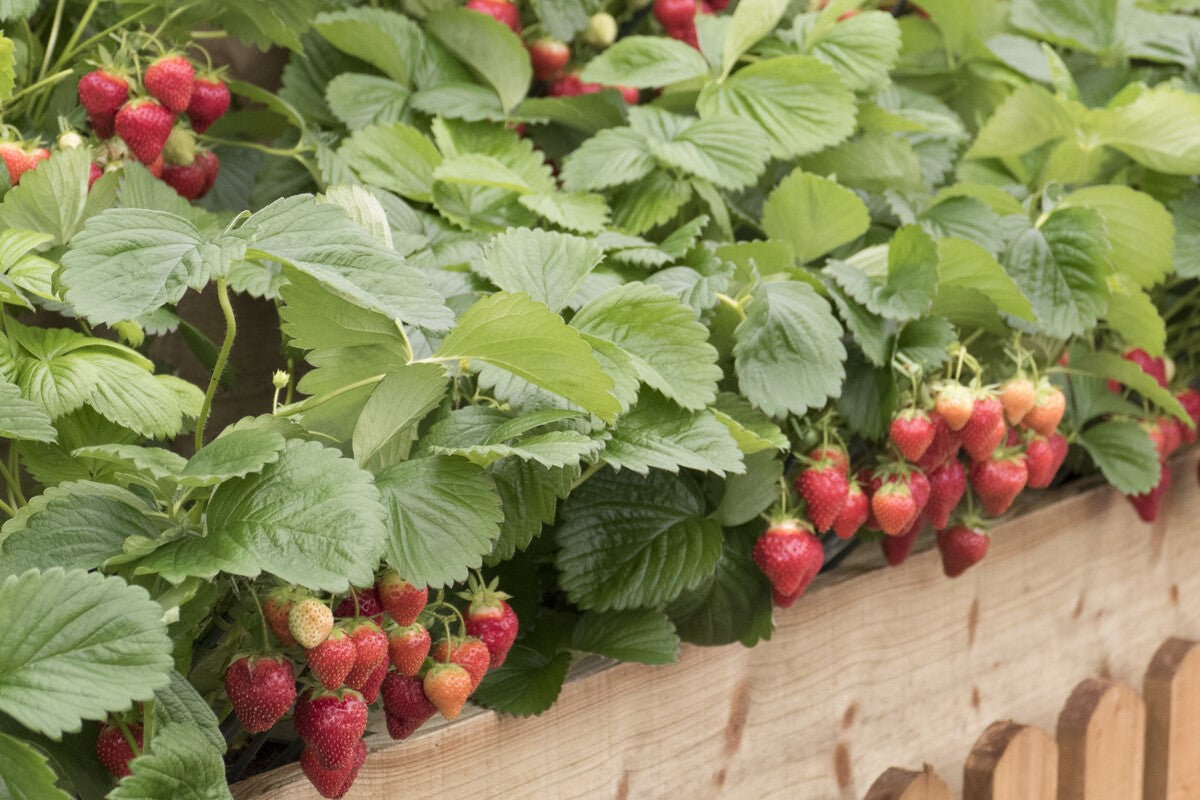
How to grow strawberries in pots
Strawberries are a great fruit to grow in pots, window boxes and hanging baskets. Growing them this way helps to stop diseases building up in the soil and keeps your plants away from the dreaded slugs! Choose pots at least 15cm wide and deep with drainage holes in the bottom, add some gravel or broken crockery to the bottom of the pot and fill with compost before planting one strawberry plant per pot. In a 30cm hanging basket you can plant 3-4 plants and in a grow bag, 6-8.
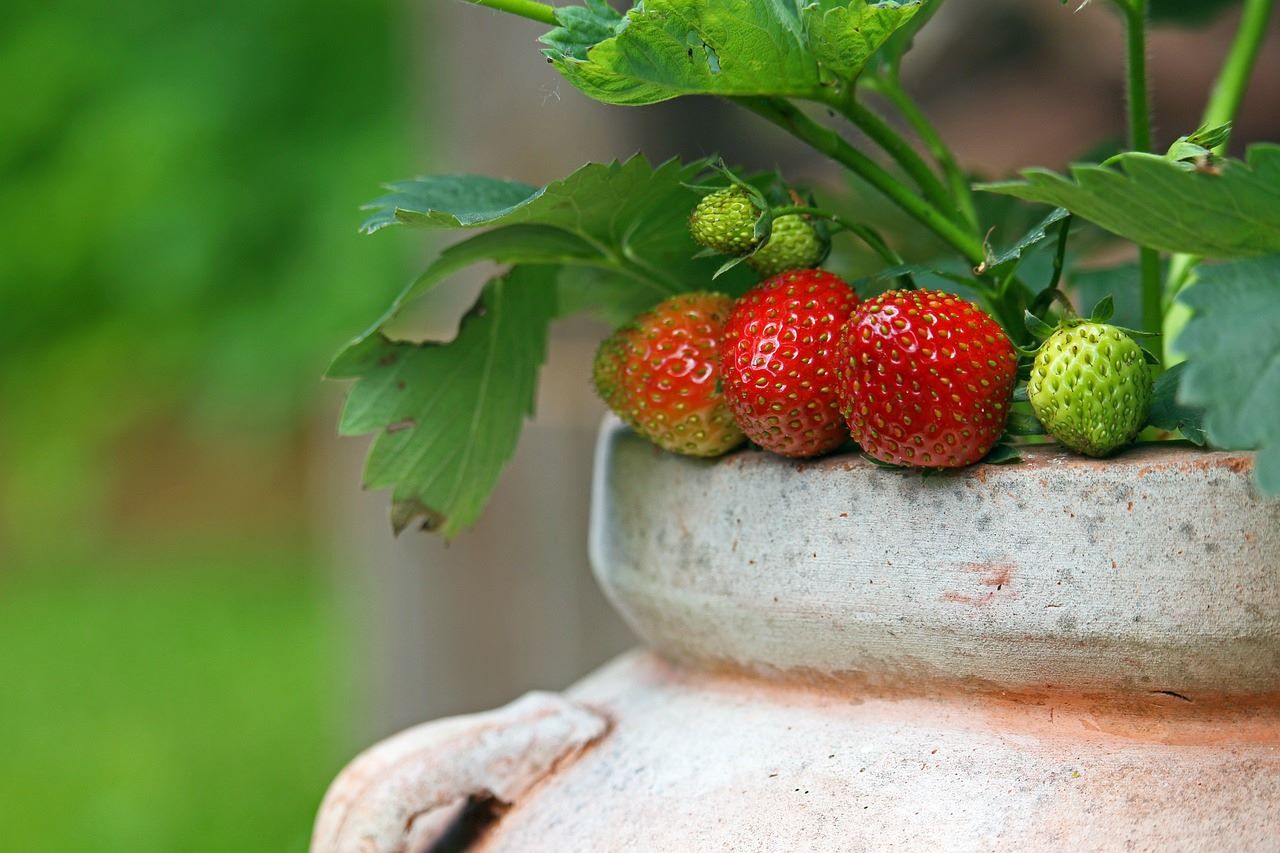
Growing strawberries in a greenhouse
Strawberries are hardy plants, so they’re good to grow outdoors, but if you need them for a specific time in June, however (*cough*Wimbledon*cough*) you can achieve an earlier crop by growing in a greenhouse or using cloches or cold frames. Not every variety is suitable for a greenhouse, so you’ll need to check - Cambridge Favourite and Honeoye are good choices.
Start your plants from bare root or runners over winter, then move them into the greenhouse in February. The one disadvantage with a greenhouse is that bees find them harder to access, so you might have to hand pollinate your flowers with a paintbrush, but given you could be enjoying your crop around two weeks earlier than strawberries grown outdoors, it’s a small price to pay.
Strawberry plant care
Watering strawberries
Strawberries need to be watered regularly when they’re newly planted, especially for the first few weeks while they’re putting down roots. Established plants won’t need watering except during the summer or throughout periods of dry weather. When you water your strawberries, try to avoid getting water on the crown or on any ripening fruit, as this could cause grey mould - watering in the morning is best if you can, as the water will then have time to evaporate from the leaves in the sun. Remember that plants in pots need more frequent watering in general, as the compost dries out more quickly.
Feeding strawberries
Strawberries need to be fed once the flowers appear, to give them enough nutrients to develop fruit. Choose a granular or liquid feed high in potassium (AKA potash) such as tomato fertiliser or blood, fish and bone, and apply this every week (for containers) or two (for strawberries in the ground).
Protecting strawberries
To avoid losing any of your strawberries to mould, damp or pests, the best thing to do is add some mulch to the surface of your soil. Straw is the most popular for strawberries (who knew) but bark chips will do the job too. Spread a generous layer of your chosen mulch on the surface of the soil around each plant or cover the whole bed. Some growers use mulch mats, weed suppressing membranes or strawberry collars as an alternative.
As regards frost protection, the plants themselves are cold hardy and will be fine through autumn and winter, but if your plants blossom early, you’ll want to keep an eye out for late frosts and protect them with a cloche, cold frame or horticultural fleece to avoid damage.
Do strawberry plants need pruning?
Full disclosure, I never have, but I’m rethinking my life choices because our grower tells me it can help the plant to retain energy and reduce the risk of moulds and mildews. After fruiting, just cut back your plants to about 5cm above ground level (or 5cm above the crown) and give them a feed of general purpose fertiliser.
This encourages new growth the following year and means that your plants should crop well for about 3-4 years before you need to replace them. This only applies to summer fruiting varieties - for autumn fruiting strawberries, all you need to do is remove any dead leaves as necessary.
How to harvest strawberries
Your strawberries will be ready for picking between June and September, depending on the variety. They won’t ripen any further once you pick them, so try to resist until they’re fully red all over. To harvest, just pull the berry away from the plant, break it off at the stalk or cut with scissors. It’s best to pick them in the afternoon (or the warmest part of the day where you are) as this is when the sugars are most concentrated and the berries are at their sweetest.
Storing and preserving your strawberries
Unwashed strawberries can only be kept for a few days in the fridge, so they need to be eaten as soon as possible after picking. If you have a particularly big crop, you can freeze your strawberries (they don’t keep their shape however, so this is only an option for cooking or blending in smoothies) or dry them. Sometimes the old ways are the best though, so why not try your hand at a batch of homemade strawberry jam?
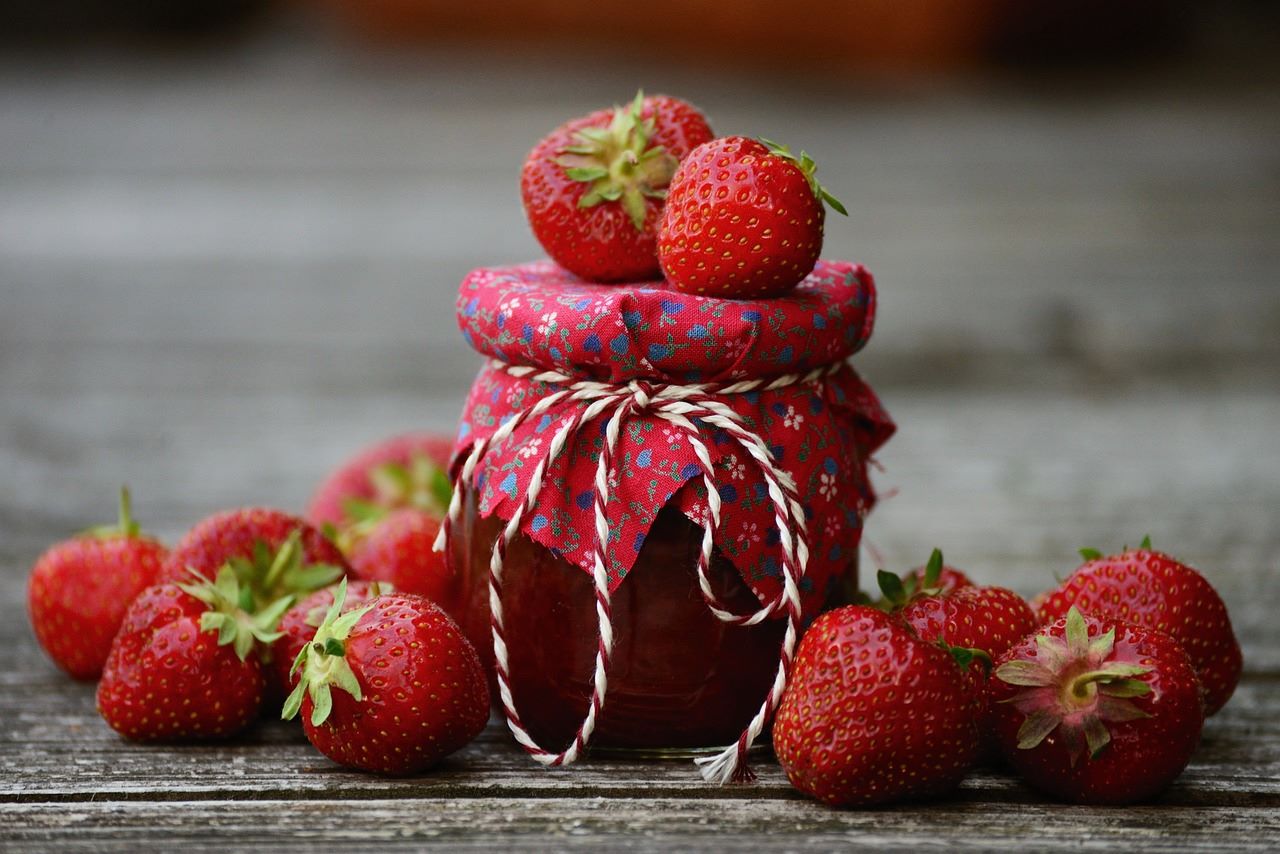
Strawberry plant problems
Grey mould
Grey mould is the last thing you want within a mile of your strawberries, but it’s a common problem for soft fruits, covering them in fuzzy grey or brown patches and causing them to decay.
To prevent this kind of horror show, make sure any dead or decaying parts of the plant are removed immediately, water in the morning rather than the evening and make sure your plants are not overcrowded. If you are growing your strawberries in a greenhouse, make sure they have good ventilation and low humidity, by frequently opening the doors and roof vents.
Strawberry black eye
If your strawberry plants flower before the last frost, this can cause problems. Black eye, as the name suggests, appears as a black centre to the flower. It happens when frost kills the reproductive parts of the flower and means that the fruit won’t develop. To prevent this, keep an eye out for early blossom, and if a frost is predicted, cover your plants at night with a horticultural fleece, then remove it in the morning once the frost has thawed, to enable pollinators to reach the flowers.
Slugs and snails
Holes in your strawberries? Telltale slimy trail? Looks like slugs or snails *shakes fist*.
You can prevent them from reaching your strawberries by laying a mulch of straw around the base of the plants just before the fruit starts to develop. You can also use bark chips in the same way. You can also make a barrier of crushed eggshells, gravel or copper wire around your plants (this is easier if you’re growing in pots) or give the tried and trusted beer traps a go. To make a beer trap, purchase the cheapest beer from the shop, sink a small bowl (like a yoghurt pot) into the ground so that it’s level with the soil and fill it with beer. In the morning you should find slugs floating in it (but at least they died happy).
Birds
How can you really blame them? Birds love ripe fruit as much as the rest of us, and those bright red berries are like a neon sign to them. Stop birds (plus squirrels and mice) eating your crops by covering your plants with netting or a fruit cage. Make sure the holes are large enough for pollinators to get to the flowers, and fix nets down firmly so that animals don’t get trapped in them.
Help! My strawberries are multiplying
Not a terrible problem to have, I’ll admit, but strawberries do reproduce like they’re trying to colonise the planet. After they’ve fruited, they’ll send out long stems called runners with baby plants attached to them. These plant themselves into the nearest soil they can find and quickly grow into a new plant.
What to do with strawberry runners
You can leave them to do their thing or to prevent overcrowding, relocate the baby plants by planting the rooted clumps where you want them to grow. Each one can be left attached to the parent plant and planted in a 9cm pot of compost until you decide. To help the baby plant to root in its new home, use hairpins or straightened out paper clips to peg down the runners (can you tell I’ve done this a lot?). Water them regularly and once you see new growth on your new plant, you can cut the runner as this is a sign that it’s rooted. If your strawberries run particularly rampant you could offer some to friends or neighbours!
